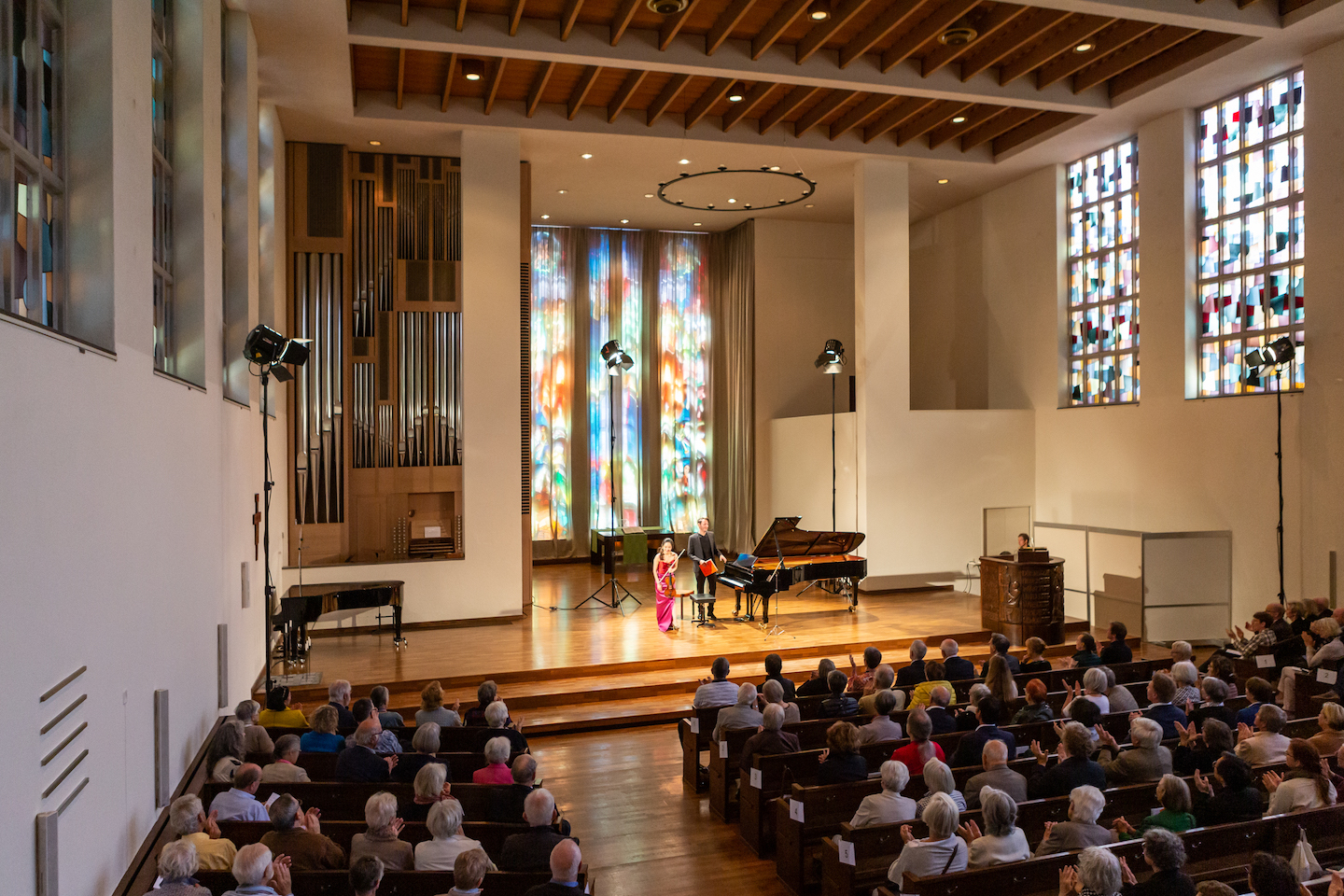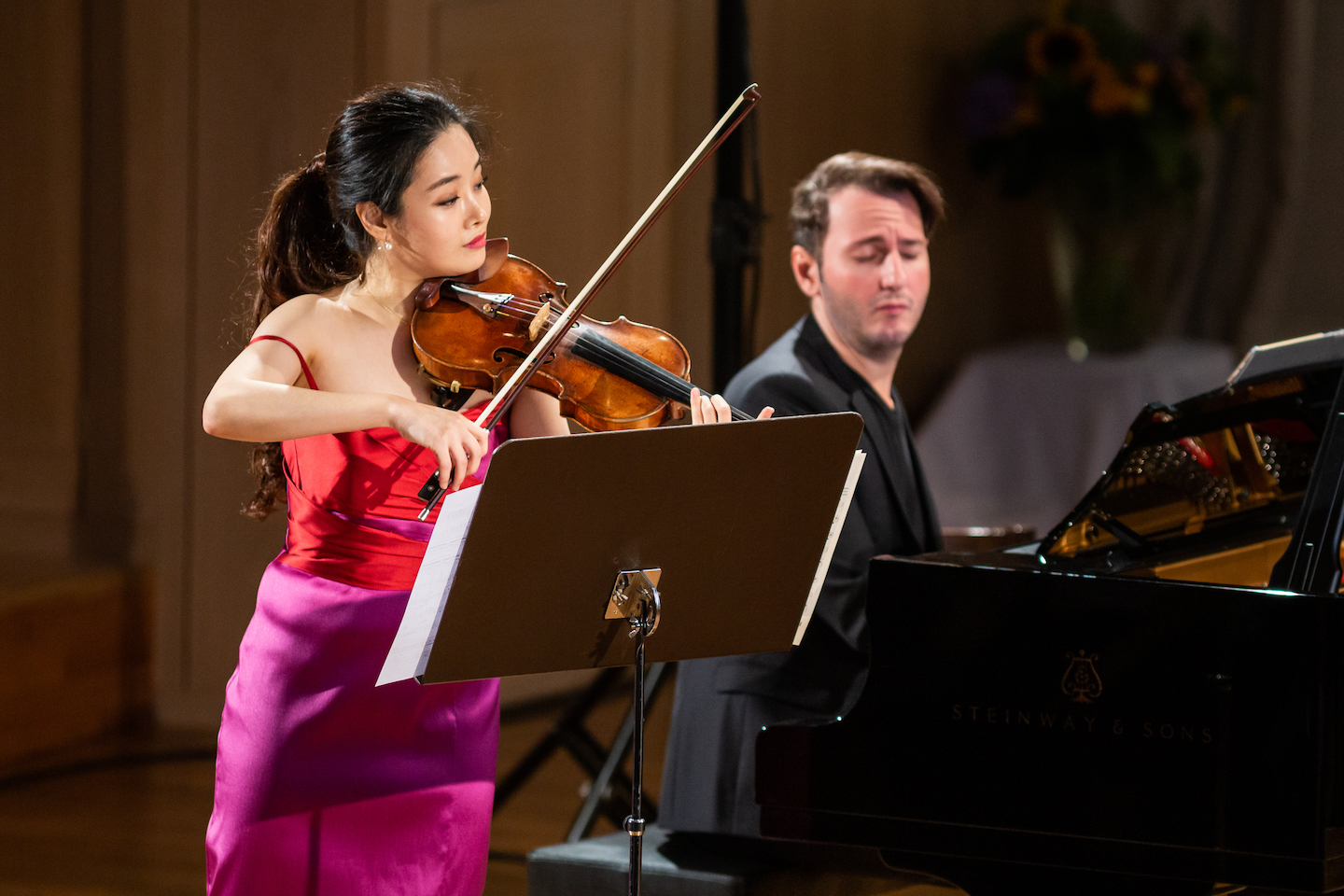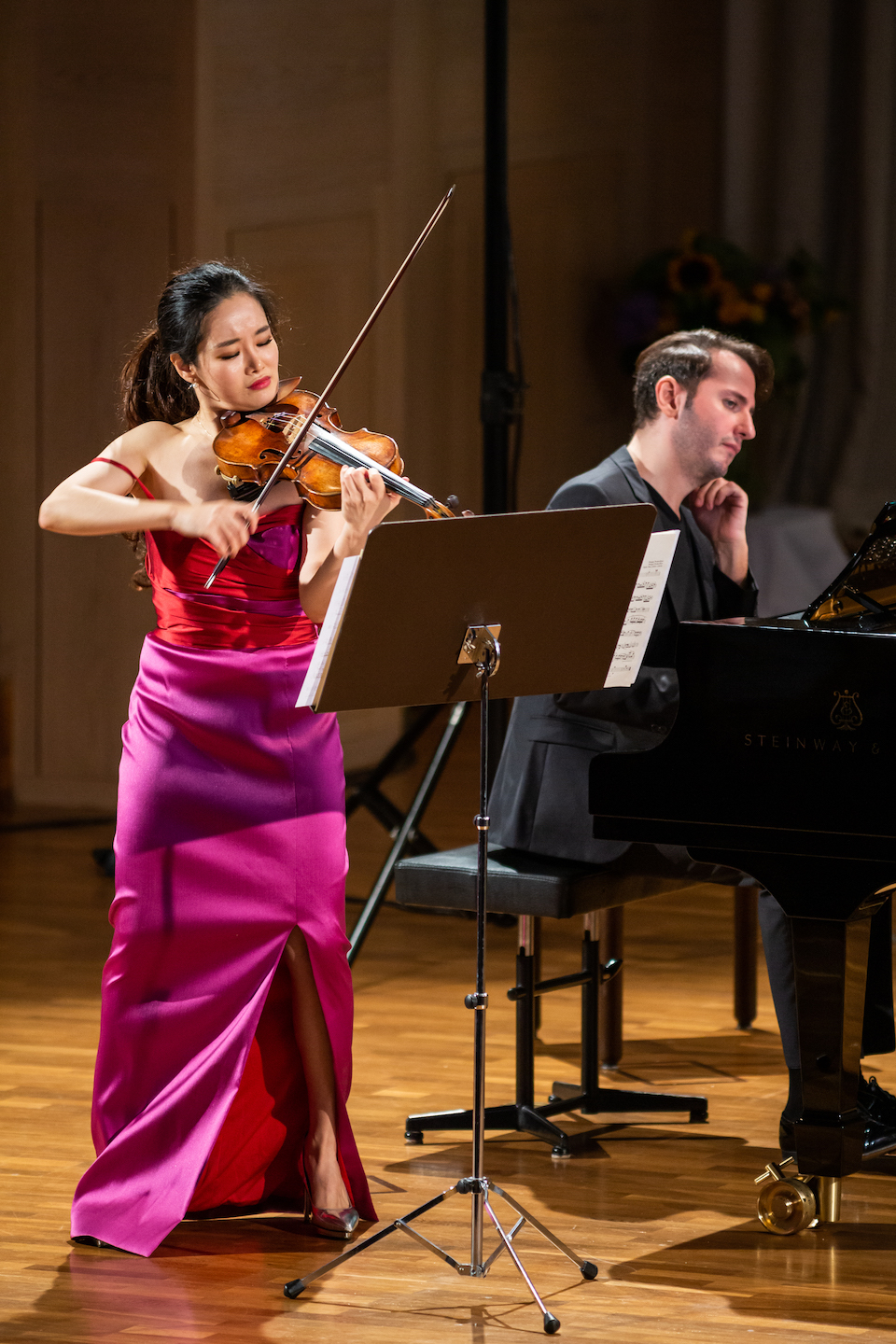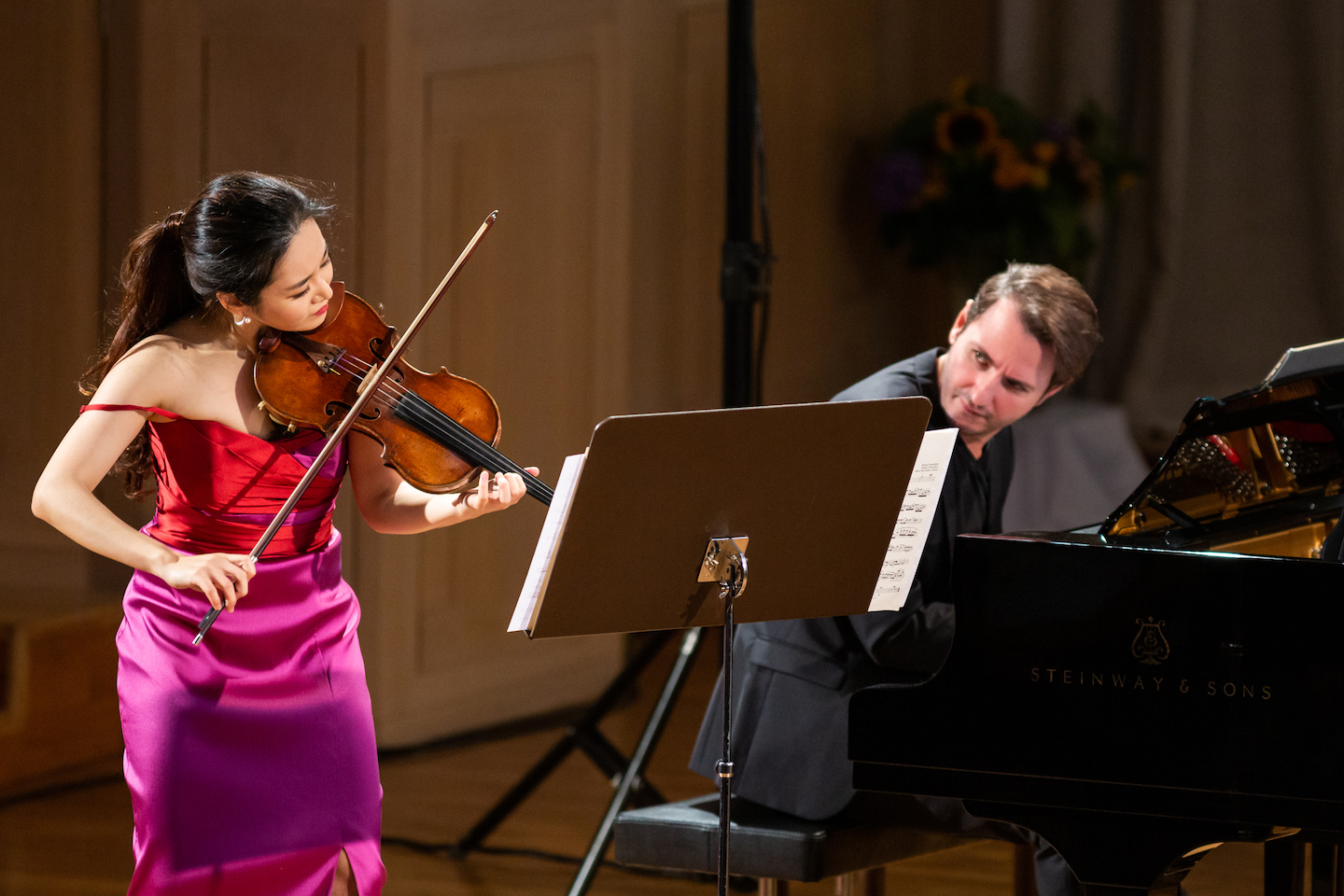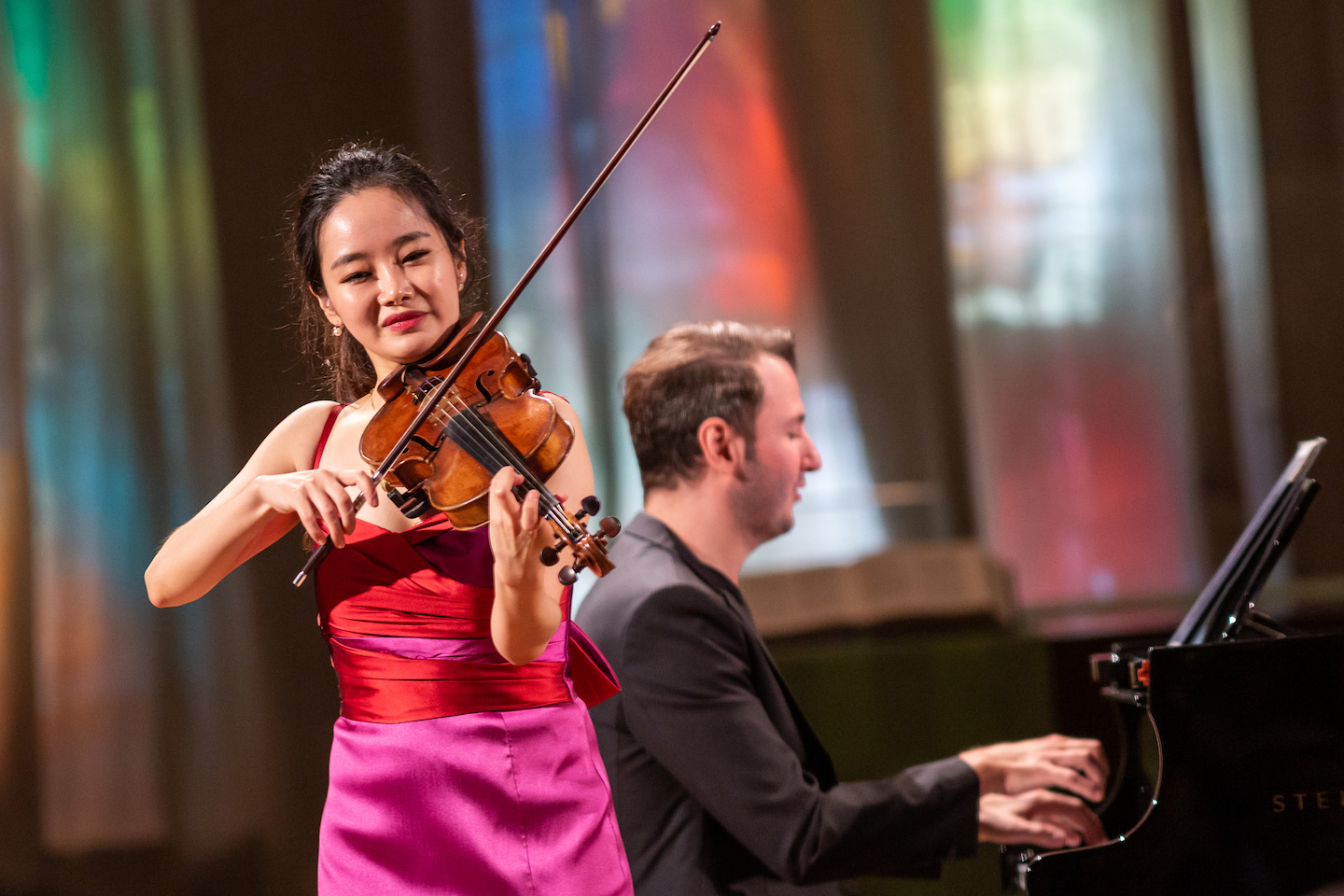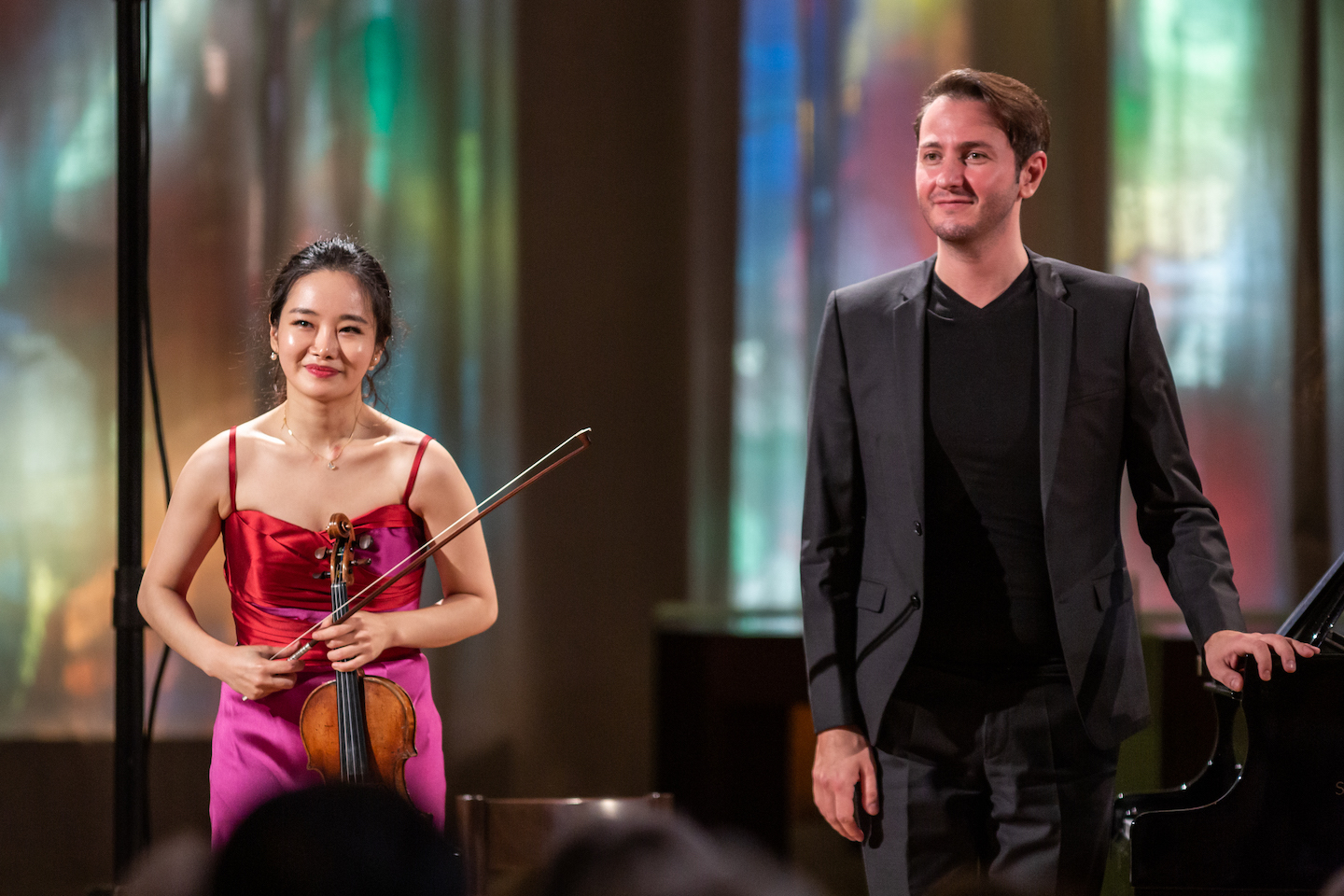Bomsori Kim, Michail Lifits
Schumann / Sibelius / Prokofiev / Waxman
Lucerne Festival — Debut Series
Lukaskirche, Lucerne, 2019-09-10

2019-09-13 — Original posting
Glänzendes Debut-Rezital in Luzern— Zusammenfassung
Zwei Jahre nach ihrem Erfolg am Internationalen Wieniawski-Wettbewerb in Poznań überzeugte die Koreanische Geigerin Bomsori Kim an ihrem Luzerner Debut in der Lukaskirche, ausgezeichnet und einfühlsam begleitet vom deutsch-usbekischen Pianisten Michail Lifits. Gefühl- und klangvoll, technisch sehr sauber und intonationssicher der Violinpart in der Schumann-Sonate, in der man sich vielleicht eine etwas schlankere, transparentere Klavierbegleitung gewünscht hätte.
Empfindsam und voller Emotionen die Auszüge aus Sibelius’ op.79. Danach wiederum größtenteils sehr überzeugend die Interpretation von Prokofiews heiterer, wenn nich oft gar unbeschwerter zweiter Sonate in D-dur. Einzig im Schlusssatz der doch recht langen Komposition ließ die Klarheit und Intonationssicherheit gelegentlich etwas nach. Franz Waxmans buntes Potpourri aus der Oper “Carmen” von Georges Bizet beschloss das offizielle Programm: ein hochvirtuoses Schaustück, brilliant gespielt, musikalisch jedoch sicher nicht ganz auf der Höhe der vorherigen Kompositionen (oder von Bizets Oper). Noch einen Schritt weiter, in Richtung Salonmusik, ging schließlich die Zugabe, das (vielleicht allzu) bekannte “Schön Rosmarin” aus den “Alt-Wiener Tanzweisen” von Fritz Kreisler.
Table of Contents
- Introduction
- The Artists
- Program
- Setting, etc.
- Robert Schumann (1810 – 1856): Violin Sonata No.1 in A minor, op.105
- Jean Sibelius (1865 – 1957): From “6 Pieces for Violin and Piano”, op.79 (Nos.1, 5, 6)
- Sergei Prokofiev (1891 – 1953): Violin Sonata No.2 in D major, op.94bis
- Franz Waxman (1906 – 1967): Carmen Fantasie
- Encore — Fritz Kreisler (1875 – 1962): “Schön Rosmarin” , from “Old Viennese Dances for Violin and Piano”
Introduction
This was the first of two Debut Series recitals in the last week of this year’s Lucerne Festival: a series that gives young, emerging talents (typically solo, duo, or other small chamber music formations) a chance to present themselves to the international festival audience. These recitals don’t take place at the main festival venue, the Lucerne Culture and Congress Centre (KKL), but at the Lukaskirche, just as close to the train station as the KKL (just on the other side). Sure, the Lukaskirche is substantially smaller than the KKL—yet, it is spacious and offers room for a fairly big audience. And both Debut Series concerts this week were sold out.
The Artists
This concert was a duo recital for violin and piano, with the Korean violinist Bomsori Kim, partnering with the Uzbek / German pianist Michail Lifits:
Bomsori Kim, Violin
Bomsori Kim (*1989) grew up in South Korea. She received a Bachelor’s degree at Seoul National University, where her main teacher was Young Uck Kim (*1947). The artist then moved to the US, where she earned her Master of Music Degree and Artist Diploma at The Juilliard School.
She first gained major public attention when she won the (shared) second prize at the 62nd ARD International Music Competition in 2013. After that, she won several additional prizes at the Tchaikovsky International Competition, the Queen Elisabeth Competition, the International Jean Sibelius Violin Competition, the Joseph Joachim International Violin Competition Hannover, the Montreal International Musical Competition and the Sendai International Music Competition. Finally, at the 15th International Henryk Wieniawski Violin Competition in Poznań in 2016, she again won the second prize. I watched some of her performances during that performance (live streaming)—and quite liked what I heard and watched.
Bomsori Kim performs on a 1774 violin by Giovanni Battista Guadagnini (1711 – 1786).
Michail Lifits, Piano
Michail Lifits (*1982, see also Wikipedia) grew up in a family of musicians in Tashkent, Uzbekistan. He moved to Germany at age 16, where he settled in Hannover. There, he studied at the Hochschule für Musik und Theater in the classes of Karl-Heinz Kämmerling (1930 – 2012) and Bernd Goetzke (*1951). Further studies took him to the Incontri col Maestro Academy in Imola, Italy, where he studied with Boris Petrushansky (*1949).
In 2009, Michail Lifits won the first prize at the Hilton Head International Piano Competition in South Carolina, as well as at the Ferruccio Busoni International Piano Competition in Bolzano, Italy. This ensured a successful start of an international career as concert pianist. Michail Lifits is a Steinway artist—and here, he performed on a Steinway D-274 concert grand, the lid fully open.
Program
Bomsori Kim’s program started with romantic music by Robert Schumann, culminated in Prokofiev’s second violin sonata, then concluded with lighter classics from the 20th century:
- Robert Schumann (1810 – 1856): Violin Sonata No.1 in A minor, op.105
- Jean Sibelius (1865 – 1957): From “6 Pieces for Violin and Piano”, op.79 (Nos.1, 5, 6)
- Sergei Prokofiev (1891 – 1953): Violin Sonata No.2 in D major, op.94bis
- Franz Waxman (1906 – 1967): Carmen Fantasie
- Encore — Fritz Kreisler (1875 – 1962): “Schön Rosmarin”, from “Old Viennese Dances for Violin and Piano”
Setting, etc.
As mentioned above, the concert was sold out. I was fairly late in booking (I only did so 3 day prior to the event). Still, I managed to get a seat in the first row in the right-hand side lateral block on the balcony. The seats are unnumbered (booking by row), but arriving 45 minutes prior to commencement, I was one of the first to enter the venue. But actually there was no rush, as my row only had four seats. I took the rightmost (corner) seat, with excellent unobstructed view onto the performance:
Robert Schumann (1810 – 1856): Violin Sonata No.1 in A minor, op.105
Robert Schumann (1810 – 1856) composed his Violin Sonata No.1 in A minor, op.105, in 1851, within 5 days. He apparently did not like the outcome (therefore I wrote a second one, which I hope has turned out better)”. To me / today’s audiences, that first sonata isn’t bad at all! The sonata premiered in March 1852, with the violinist Ferdinand David (1810 – 1873), and with Robert’s wife Clara Schumann-Wieck (1819 – 1896) at the piano. The sonata features the following three movements:
- Mit leidenschaftlichem Ausdruck
- Allegretto
- Lebhaft
The Performance
With her entrance onto the stage, Bomsori Kim gave the impression of a self-assured, young artist, devoid of stage anxiety. Well, she has gone through major competitions just in 2016—and these were much more strainful on her nerves, than a regular concert. The violinist placed her music stand close to the right edge of the keyboard, performing very close to the pianist. The lid of the Steinway remained fully open at all times.
I. Mit leidenschaftlichem Ausdruck
The beginning of Schumann’s violin sonata op.105 instantly exposed the full, warm tone of Bomsori Kim’s Guadagnini violin, especially in the low register. The instrument had no problem projecting through the sound of the concert grand. This held true throughout the recital, which indicates Michail Lifits’ diligence as a careful accompanist. Though, especially in the Schumann sonata I noted the pianist’s tendency for excess use of the sustain pedal—which in the church acoustics made the instrument sound rather diffuse, “cloudy”. At the very least, Michail Lifits should have adjusted the pedaling and the articulation to the venue. Not only compensating for the acoustics, but also considering that the sonority of the Steinway grand is a far cry from that of pianos at the time of the composition.
Bomsori Kim demonstrated the beautiful sonority of her instrument. However, she also was excellent at picking up on Schumann’s expressive, emotional musical language. She played impulsively, was harmonious in the musical gestures, lively in her body movements and language. It was definitely an impressive performance on her part. She knows her part almost by heart, often playing without looking at the score. The way she positioned herself on the stage, she only had sporadic (and rather indirect) contact with the pianist. Still, the performance also showed that the two musicians were not only familiar with the music, but also with each other’s musical intent.
★★★★½ (violin) / ★★★½ (piano)
II. Allegretto
I liked not only the lyrical singing of the violin, but also the excellent use of rubato, the excellent, harmonious transitions (the score is full of explicit ritenuto , fermata and A tempo annotations). And I enjoyed the limited vibrato: it was inconspicuous, harmonious, and the violinist did not shy away from leaving specific, long notes entirely without vibrato (e.g., the F” preceding the closing gesture).
★★★★
III. Lebhaft
A virtuosic tempo, with excellent, light and clear spiccato articulation on Bomsori Kim’s part. On the piano part, Schumann explicitly annotates Nicht gebunden (i.e., non-legato). And indeed, the piano now sounded clearer, even though sometimes retained some of the somewhat “cloudy” sonority in this venue. Musically, the movement was an alert, lively dialog between the two instruments, which were imitating each other’s semiquaver motifs in a refreshingly animated exchange, with the occasional, highly lyrical intermezzo. Thanks to the artists for observing Schumann’s repeats!
★★★★
Overall Rating: ★★★★
Jean Sibelius (1865 – 1957): From “6 Pieces for Violin and Piano”, op.79 (Nos.1, 5, 6)
Jean Sibelius (1865 – 1957) wrote his 6 Pieces for Violin and Piano, op.79 around 1915 – 1918. Very little is known about the circumstances and the concrete purpose of these small works. However, the general assumption is that Sibelius composed many of the round 40 pieces (mostly in groups of 4 – 6 pieces) in an effort to reduce his enormous debts. Hence the popular style of these compositions (character pieces), which are suited for home playing by lay or semi-professional violinists. Out of the 6 pieces in op.79, Bomsori Kim selected the numbers 1, 5, and 6:
- Souvenir
- Tempo di minuetto
- Danse caractéristique
- Sérénade
- Danse idyll
- Berceuse
The Performance
Here now, Bomsori Kim move the music stand away—demonstratively performing these pieces by heart. Though, on second thought, she really wasn’t in need of proving anything to the audience!
I. Souvenir
Amazing how already in the very first bars, on the G and D strings Bomsori Kim was able to produce the full, warm sonority of a viola on her Guadagnini violin! She now applied more (and more continuous) vibrato, which I consider adequate for Sibelius’ music. Occasionally, however, the vibrating was on the border of sounding a bit nervous. Her intonation remained firm and very clean, also in double-stop playing and in rapid figures, an up to highest pitches on the E string. The arpeggiated piano accompaniment set the appropriate, romantic mood. Obviously, Sibelius wrote this with the modern concert grand in mind.
★★★½
V. Danse idyll
Technically very clean on the violin, excellent and detailed in phrasing and articulation, truthful to Sibelius notation. The beginning felt lyrical, with the light, “airy” piano accompaniment, like butterflies moving between flowers (with excellent and balanced sonority). Excellent, natural transitions into and out of the lively, vivid stretto segments. And also here, Bomsori Kim’s intonation remained clear when she made the instrument whistle like birds in the highest segments.
★★★★
VI. Berceuse
A short “cradle song”, but nevertheless full of blooming emotions down to the smallest of motifs, like a sequence of short takes / pictures, mostly in the middle tonal range, with occasional excursions up to the highest of whistling flageolets. Very clean playing and pure intonation, swaying, often hesitant, pensive in the rhythm: very nice!
★★★★
Overall Rating: ★★★★
Sergei Prokofiev (1891 – 1953): Violin Sonata No.2 in D major, op.94bis
The list of works by Sergei Prokofiev (1891 – 1953) includes two violin sonatas. Of these, the second one in D major, op.94bis, appeared first— and it isn’t really a genuine violin sonata. Rather, 1942, the violinist David Oistrakh (1908 – 1974) heard Prokofiev’s Flute Sonata in D major, op.94. And he urged the composer to rework this for violin and piano. Prokofiev indeed transformed the sonata for violin and piano during the Second World War. At that time, he was living in a remote shelter in Perm, in the Ural Mountains. 1944, the Violin Sonata No.2 in D major, op.94bis premiered with David Oistrakh at the violin, Lev Oborin (1907 – 1974) at the piano. The sonata still often reminds of its origins as Flute music. There are four movements:
- Moderato
- Scherzo: Presto – Poco più mosso – Tempo I
- Andante
- Allegro con brio – Poco meno mosso – Tempo I – Poco meno mosso – Allegro con brio
Despite the later publication, the lower numbering (No.1) for the “other” violin sonata (op.80, in F minor) is still justified, as Prokofiev had started that composition back in 1938.
As part of a brief CD review, I have also written about Prokofiev’s op.94bis in an earlier blog post.
The Performance
I. Moderato
An atmospheric performance, full of warm emotions. Maybe the tempo initially was a tad too measured? In my impression, the repeat of the exposition felt slightly more fluent. The music alternates between serene, lyrical segments evoking sprint feelings, and more resolute and virtuosic moments, such as at [4], after the exposition. In both we again experienced Bomsori Kim’s firmness in intonation, and the excellent partnership between violinist and pianist. Throughout the recital, I never sensed any discrepancy or disagreement between the two musicians. I felt that Michail Lifits (7 years the violinist’s senior) was adapting perfectly to the violinist’s playing, rarely ever actively taking the lead: excellent accompaniment!
★★★★
II. Scherzo: Presto – Poco più mosso – Tempo I
A movement full of witty accents, sparkling in rhythmic intricacies! Both artists were very agile in their playing, technically clean, virtuosic. I’m tempted to state that the attitude sometimes felt almost ghastly. However, at the same time, the music was full of joy, worldly life, playfulness—fascinating! My only minor quibble: maybe sometimes that piano was a tad too loud? Still, spontaneous applause started to break out: clearly, the audience was fascinated!
★★★★½
III. Andante
Subtle music, performed with fine balance and tuning between the two parts, which constantly and frequently alternate in their roles: once more an excellent dialog in serene, unstrained atmosphere. And Bomsori Kim’s intonation again was flawless!
★★★★★
IV. Allegro con brio – Poco meno mosso – Tempo I – Poco meno mosso – Allegro con brio
Joyful and full of life! In general, Michail Lifits’ piano playing was excellent, with superb dynamic control (e.g., where Prokofiev differentiates between left- and right hand dynamics, such as in the Tempo I section. The violin part is highly challenging in the intonation, especially in the more rapid segments. Bomsori Kim didn’t always quite manage to maintain the clean intonation that she exhibited in the previous movements. Not only the violin voice, but also the piano part showed occasional superficialities (the former in intonation, the latter in the articulation of some semiquaver motifs). Overall, I felt that this movement required some more coherence and apollonian clarity in expression, articulation and agogics.
★★★½
Overall Rating: ★★★★
Franz Waxman (1906 – 1967): Carmen Fantasie
Franz Waxman (1906 – 1967) was born as Franz Wachsmann the German Empire’s Prussian Province of Silesia (now Chorzów, Poland). Following his father’s will, he started his professional career working as cashier in a bank. The money he earned, he invested in his music education. Also his subsequent music education was essentially self-financed. Waxman played in bars, night clubs and Jazz bands. That effort was worth it: Waxman became a prominent composer for film music in Hollywood. His Carmen Fantasie originated as music for the 1946 film Humoresque, featuring an older woman/younger man tale about a violinist and his patroness. In that firm, the soundtrack was performed by Jascha Haifetz (1901 – 1987). As the title indicates, the piece is a pot-pourri of popular themes from the 1875 opera Carmen by Georges Bizet (1838 – 1875).
The Performance
Not surprisingly, Bomsori Kim switched back to playing by heart: I’m sure she played this virtuosic showpiece in past competitions! Given the time of the composition, and the fact that Jascha Haifetz first performed this music (for the film soundtrack), strong and ubiquitous vibrato is certainly justified here. Still, it occasionally felt a bit excessive. In the first part, it seemed that the artists focused on the showpiece aspect: for opera music, I would expect more drama, ritenuti and the like. Sometimes, the performance was “too much moving forward”: not opera, but violin virtuoso music.
I liked the central part better, with its intense playing in the middle range, and the fascinatingly clean cadenza. Michail Lifits was very attentive, but largely did not interfere with the role of the primadonna. He was rather limiting his function to that of the accompanist. At the same time, Bomsori Kim was shining with extreme virtuosic artistry and high, clean flageolet playing. There were short moments where the tension seemed to drop a tad. However, I attribute this to Waxman’s arrangement, rather than to the artist’s playing. Needless to say that towards the end, the strong, enthralling accelerando turned into a veritable furioso, seemingly involving witchcraft on the part of the violinist: Brilliant!
Rating: ★★★★
Encore — Fritz Kreisler (1875 – 1962): “Schön Rosmarin”, from “Old Viennese Dances for Violin and Piano”
In 1910/1911, Fritz Kreisler (1875 – 1962), the pre-eminent violinist in the first half of the 20th century, published his “Old Viennese Dances for Violin and Piano” (Alt-Wiener Tanzweisen)—three short pieces, salon music of sorts, or pieces intended to be used as encores? The pieces are all well-known; Bomsori Kim selected the last one as encore:
- Liebesfreud (“Love’s Joy”, Allegro)
- Liebesleid (“Love’s Sorrow”, Tempo di Ländler)
- Schön Rosmarin (“Lovely Rosemary”, Grazioso)
With the encore, we definitely moved into the domain of salon music: sentimental, very warm-hearted, not very demanding musically, but “very Viennese”. It may not seem to be the ideal, fitting closure considering Prokofiev’s sonata. However, thanks to the mediating function of the Waxman piece, we could certainly enjoy this as very atmospheric ending for a fascinating, (mostly / largely) compelling debut performance: we hope to hear either of these artists again soon!




